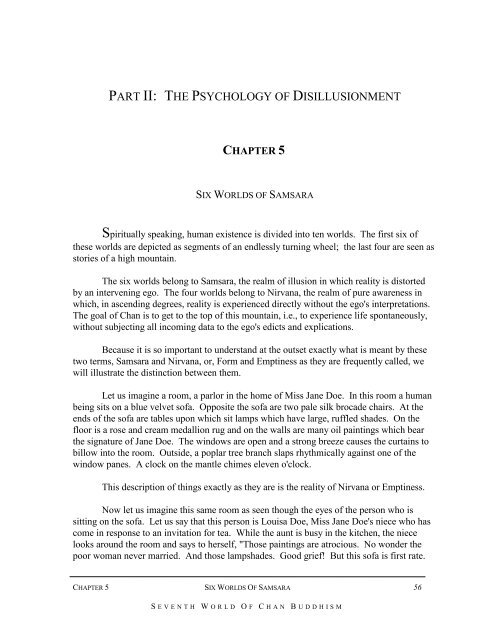seventh world of chan buddhism - Zen Buddhist Order of Hsu Yun
seventh world of chan buddhism - Zen Buddhist Order of Hsu Yun
seventh world of chan buddhism - Zen Buddhist Order of Hsu Yun
You also want an ePaper? Increase the reach of your titles
YUMPU automatically turns print PDFs into web optimized ePapers that Google loves.
PART II: THE PSYCHOLOGY OF DISILLUSIONMENT<br />
CHAPTER 5<br />
SIX WORLDS OF SAMSARA<br />
Spiritually speaking, human existence is divided into ten <strong>world</strong>s. The first six <strong>of</strong><br />
these <strong>world</strong>s are depicted as segments <strong>of</strong> an endlessly turning wheel; the last four are seen as<br />
stories <strong>of</strong> a high mountain.<br />
The six <strong>world</strong>s belong to Samsara, the realm <strong>of</strong> illusion in which reality is distorted<br />
by an intervening ego. The four <strong>world</strong>s belong to Nirvana, the realm <strong>of</strong> pure awareness in<br />
which, in ascending degrees, reality is experienced directly without the ego's interpretations.<br />
The goal <strong>of</strong> Chan is to get to the top <strong>of</strong> this mountain, i.e., to experience life spontaneously,<br />
without subjecting all incoming data to the ego's edicts and explications.<br />
Because it is so important to understand at the outset exactly what is meant by these<br />
two terms, Samsara and Nirvana, or, Form and Emptiness as they are frequently called, we<br />
will illustrate the distinction between them.<br />
Let us imagine a room, a parlor in the home <strong>of</strong> Miss Jane Doe. In this room a human<br />
being sits on a blue velvet s<strong>of</strong>a. Opposite the s<strong>of</strong>a are two pale silk brocade chairs. At the<br />
ends <strong>of</strong> the s<strong>of</strong>a are tables upon which sit lamps which have large, ruffled shades. On the<br />
floor is a rose and cream medallion rug and on the walls are many oil paintings which bear<br />
the signature <strong>of</strong> Jane Doe. The windows are open and a strong breeze causes the curtains to<br />
billow into the room. Outside, a poplar tree branch slaps rhythmically against one <strong>of</strong> the<br />
window panes. A clock on the mantle chimes eleven o'clock.<br />
This description <strong>of</strong> things exactly as they are is the reality <strong>of</strong> Nirvana or Emptiness.<br />
Now let us imagine this same room as seen though the eyes <strong>of</strong> the person who is<br />
sitting on the s<strong>of</strong>a. Let us say that this person is Louisa Doe, Miss Jane Doe's niece who has<br />
come in response to an invitation for tea. While the aunt is busy in the kitchen, the niece<br />
looks around the room and says to herself, "Those paintings are atrocious. No wonder the<br />
poor woman never married. And those lampshades. Good grief! But this s<strong>of</strong>a is first rate.<br />
CHAPTER 5 SIX WORLDS OF SAMSARA<br />
S EVENTH W ORLD O F C HAN B UDDHISM<br />
56


